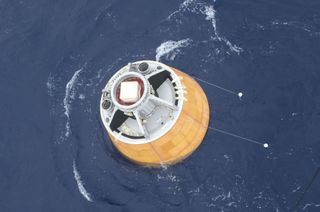India's Prototype Space Capsule Passes Big Test

BANGALORE, India — In a two-in-one mission, the Indian Space Research Organisation (ISRO) successfully conducted the first experimental flight of its next-generation launch vehicle and demonstrated the re-entry and recovery of a prototype crew capsule.
The Dec. 18 maiden flight of the Geosynchronous Satellite Launch Vehicle Mark 3 (GSLV-3) began with a liftoff at 9:30 a.m local time from the Satish Dhawan Space Center on the southeastern coast of India and was over in 20 minutes.
ISRO said in a statement that this "suborbital" experimental mission was intended to test the vehicle performance during the critical atmospheric phase of its flight. The vehicle carried a passive, or nonfunctional, cryogenic upper stage. [See photos from India's space capsule test flight]
The rocket carried a 3,775-kilogram unmanned crew module built by Indian industry. The module, designed to accommodate three astronauts, separated from the rocket at an altitude of 127 kilometers and, after being slowed by parachutes, splashed down in the Bay of Bengal.
The 42.4-meter tall GSLV-3 is a three-stage vehicle with a liftoff weight of 630 metric tons. The first stage consists of two solid-rocket motors, each with 200 tons of propellant. Its second stage uses two restartable engines, with 110 tons of liquid propellant.
As designed, the cryogenic upper stage of the rocket features a propellant loading of 25 tons of liquid-oxygen and -hydrogen. But in this flight only the first two stages were fired; the cryogenic upper stage was inert. The mission objective was to test the first two stages — they had never flown before — and validate the rocket’s aerodynamic stability during the ascent phase through the atmosphere.

ISRO said in a statement that the flight aimed "to validate the re-entry technologies envisaged for crew module and enhance the understanding of blunt body re-entry aerodynamics and parachute deployment in cluster configuration." With the success the rocket "has moved a step closer to its first developmental flight with the functional cryogenic upper stage."
Get the Space.com Newsletter
Breaking space news, the latest updates on rocket launches, skywatching events and more!
"It has been a significant day for ISRO," the agency's chairman, Koppilli Radhakrishnan, said in a post-launch speech. "The performance of solid and liquid stage motors and the unmanned crew module was as expected."
Radhakrishnan said the rocket's cryogenic upper stage is still in development and that he is confident the first full-fledged flight will take place in two years. Once ready, he said, the GSLV-3 will be able to launch satellites weighing 4 tons and could be used for the Indian manned spaceflight program.
The GSLV-3, in development since 2002, was initially expected to become operational by 2010 or 2011, with its first flight in 2009 or 2010. The demonstration flight was pushed back several times, one reason being the failure of the home-made cryogenic upper stage during a 2010 flight of the current-generation GSLV.
ISRO has sought about 125 billion rupees ($1.9 billion) for its human spaceflight endeavor but India’s government has yet to approve the funding.
Radhakrishnan has said that ISRO could send astronauts to space within seven to eight years of getting a government nod.
This story was provided by SpaceNews, dedicated to covering all aspects of the space industry.
Join our Space Forums to keep talking space on the latest missions, night sky and more! And if you have a news tip, correction or comment, let us know at: community@space.com.
Dr. Killugudi S. Jayaraman holds a PhD in nuclear physics from the University of Maryland and a master’s degree in journalism from the Medill School of Journalism at Northwestern University. According to the Biotech Times, Dr. Jayaraman played a critical role in Indian science journalism, placing Indian science on a global platform. He was the first Science Editor of the Press Trust of India (PTI), editor of Nature India and Science Editor with IANS. His work can be found in many Indian and international publications.
Most Popular


